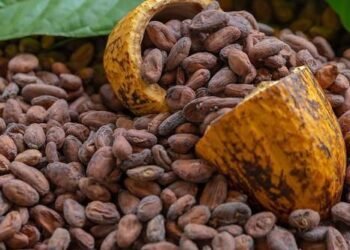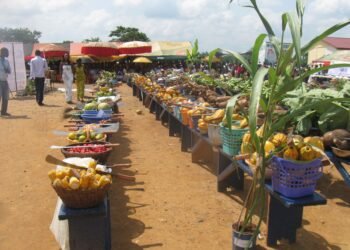The Council for Scientific and Industrial Research–Savanna Agricultural Research Institute (CSIR-SARI) has taken a bold step in revolutionizing soybean production in Ghana.
Through an on-farm demonstration held at Salaga in the East Gonja Municipality of the Savannah Region, the Institute’s Soybean Breeding Team showcased a new generation of high-yielding, high pod clearance, and early-maturing soybean lines.
The initiative, which forms part of CSIR-SARI’s Participatory Varietal Selection (PVS) approach, is designed to bridge the gap between scientific research and the practical realities faced by farmers. It empowers farmers to directly engage in the evaluation, testing, and selection of improved soybean varieties that meet their production needs and environmental conditions.
Speaking during the event, Dr. Ophelia Asiri Amoako, Agronomist and Senior Research Scientist at CSIR-SARI, explained that the PVS approach allows farmers to play an active role in determining which varieties best suit their fields.
“Through the PVS, farmers evaluate, rank, and score soybean lines based on characteristics such as yield, pod size, early maturity, pod clearance, plant vigor, drought tolerance, and resistance to pests and diseases.”
Dr. Ophelia Asiri Amoako
Dr. Amoako noted that many farmers in the area struggle with low yields, poor soil fertility, and pest attacks, often resulting from limited fertilizer use, poor spacing, and irregular planting methods. By involving farmers directly in research and training, CSIR-SARI aims to promote better agronomic practices and increase productivity across soybean-producing communities.
Introducing High Pod Clearance and Early-Maturing Varieties
The on-farm demonstration featured two major innovations — soybean lines with high pod clearance to support mechanized harvesting, and early-maturing traits that enable resilience against unpredictable rainfall patterns caused by climate change.
According to Dr. Charles Nelimor, Research Scientist and Soybean Breeder at CSIR-SARI, these traits are crucial for modernizing soybean production. “The high pod clearance line allows for easy mechanized harvesting, reducing postharvest losses, while the early-maturing line ensures farmers can harvest before drought conditions set in,” he explained.
The demonstration combined “mother and baby trials,” where researchers managed the mother trial to exhibit improved agronomic practices, including row planting, proper spacing, and fertilizer application. Farmers were then given seed packages for their own “baby trials” to compare the new soybean lines with their traditional varieties.
Farmers Witness the Difference
Farmers who participated in the demonstration expressed enthusiasm about the results. Mr. Osman Suleman, a farmer from Salaga who supported the SARI team in managing the field activities, described the initiative as a game changer.
“This demonstration is very important for our community. It has helped us understand improved farming methods that can boost yields even on small plots. After seeing the results on the field, many farmers are motivated to adopt these new practices.”
Mr. Osman Suleman
Mr. Suleman also identified harvesting as a major challenge for soybean farmers in the area, noting that manual harvesting often causes delays and significant postharvest losses. “The introduction of high pod clearance lines is a timely solution. It will allow us to use mechanized harvesters and make our operations more efficient,” he added.
Other farmers observed visible differences between the new lines and their traditional varieties, highlighting the improved pod formation, plant height, and general vigour of the new soybean lines.
Ensuring Research Benefits Farmers
Dr. Francisca Addae-Frimpomaah, Head of the Soybean Breeding Team at CSIR-SARI, emphasized that the goal of the programme is to ensure that research outcomes are not confined to laboratories but directly benefit the farming community.
“Our objective is not to develop varieties that stay on research shelves. We want farmers to cultivate and benefit from them once released,” she said. Dr. Addae-Frimpomaah noted that involving farmers in the process helps them understand the unique traits of new varieties and the reasons they should consider planting them when they become commercially available.
She further appealed to the government to reverse the current ban on soybean exports, explaining that the restriction has negatively affected farmers’ income.
“The ban has made it difficult for farmers to sell their produce since bulk buyers who used to export no longer come to purchase from them. Lifting the ban will open up market opportunities and motivate farmers to expand production.”
Dr. Francisca Addae-Frimpomaah
Strengthening the Future of Soybean Farming
The demonstration forms part of CSIR-SARI’s broader mission to develop resilient, high-performing crop varieties tailored to the ecological conditions of Northern Ghana. By merging scientific innovation with farmer participation, the Institute aims to boost national food security, enhance livelihoods, and promote climate-smart agriculture.
The successful introduction of high pod clearance and early-maturing soybean lines marks a new dawn for Ghana’s soybean value chain. These improved varieties are expected to reduce the drudgery of manual harvesting, improve productivity, and make soybean cultivation more profitable and sustainable for smallholder farmers.
The CSIR-SARI on-farm demonstration at Salaga is a clear example of how participatory research can drive agricultural transformation. By bringing scientists and farmers together, the initiative is not only introducing better soybean varieties but also building knowledge, confidence, and community-driven progress.
READ ALSO:Banking Sector Profit Surges to GH¢9.7bn in 2025 as Income Lines Soar Across Board























